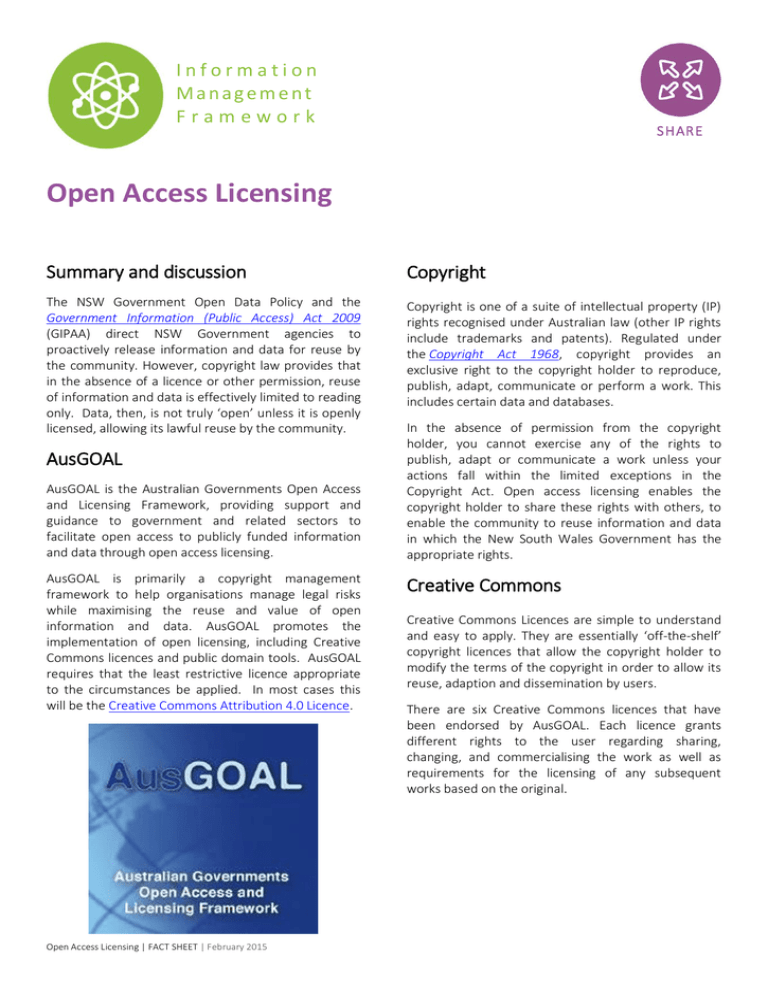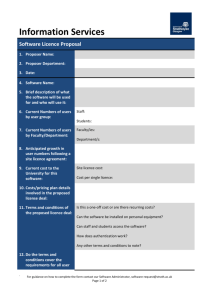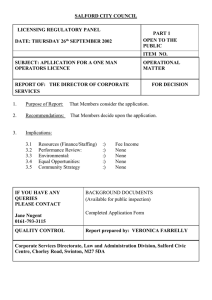
Information
Management
Framework
SHARE
Open Access Licensing
Summary and discussion
Copyright
The NSW Government Open Data Policy and the
Government Information (Public Access) Act 2009
(GIPAA) direct NSW Government agencies to
proactively release information and data for reuse by
the community. However, copyright law provides that
in the absence of a licence or other permission, reuse
of information and data is effectively limited to reading
only. Data, then, is not truly ‘open’ unless it is openly
licensed, allowing its lawful reuse by the community.
Copyright is one of a suite of intellectual property (IP)
rights recognised under Australian law (other IP rights
include trademarks and patents). Regulated under
the Copyright Act 1968, copyright provides an
exclusive right to the copyright holder to reproduce,
publish, adapt, communicate or perform a work. This
includes certain data and databases.
AusGOAL
AusGOAL is the Australian Governments Open Access
and Licensing Framework, providing support and
guidance to government and related sectors to
facilitate open access to publicly funded information
and data through open access licensing.
AusGOAL is primarily a copyright management
framework to help organisations manage legal risks
while maximising the reuse and value of open
information and data. AusGOAL promotes the
implementation of open licensing, including Creative
Commons licences and public domain tools. AusGOAL
requires that the least restrictive licence appropriate
to the circumstances be applied. In most cases this
will be the Creative Commons Attribution 4.0 Licence.
Open Access Licensing | FACT SHEET | February 2015
In the absence of permission from the copyright
holder, you cannot exercise any of the rights to
publish, adapt or communicate a work unless your
actions fall within the limited exceptions in the
Copyright Act. Open access licensing enables the
copyright holder to share these rights with others, to
enable the community to reuse information and data
in which the New South Wales Government has the
appropriate rights.
Creative Commons
Creative Commons Licences are simple to understand
and easy to apply. They are essentially ‘off-the-shelf’
copyright licences that allow the copyright holder to
modify the terms of the copyright in order to allow its
reuse, adaption and dissemination by users.
There are six Creative Commons licences that have
been endorsed by AusGOAL. Each licence grants
different rights to the user regarding sharing,
changing, and commercialising the work as well as
requirements for the licensing of any subsequent
works based on the original.
6 Creative Commons licences
The 6 Creative Commons Licences endorsed by
AusGOAL are the following:
Attribution (CC BY) Licence
Attribution, Non-Commercial (CC BY-NC) Licence
This licence allows others to distribute, adapt, and
build upon government material, for commercial and
non-commercial purposes, as long as they attribute
the government as the source of the original material.
This licence allows others to distribute, adapt, and
build upon government material, as long as they
attribute the government as the source of the original
material. However, the use must be non-commercial.
This is the least restrictive of the AusGOAL endorsed
licences and allows for the greatest possible reuse of
licensed material. This is the default licence endorsed
for use by NSW Government agencies.
Attribution-NonCommercial-ShareAlike (CC BY-NC-SA)
Licence
This licence allows others to distribute, adapt, and
build upon government material, as long as they
attribute the government as the source of the original.
However, the use must be non-commercial and new
works based the original must carry the same licence.
Attribution-ShareAlike (CC BY-SA) Licence
This licence allows others to distribute, adapt, and
build upon government material, for commercial and
non-commercial purposes, as long as they attribute
the government as the source of the original material.
This licence also requires that any new works based
the original carry the same licence.
Attribution-NonCommercial-NoDerivatives (CC BY-NCND) Licence
This licence allows other to distribute government
material, as long as they attribute the government as
the source of the original material. However, it does
not allow others to adapt, build upon or make changes
to the original material (create derivatives), and the
use must be non-commercial.
Attribution-NoDerivatives (CC BY-ND) Licence
This licence allows other to distribute government
material, for commercial and non-commercial
purposes, as long as they attribute the government as
the source of the original material. However, it does
not allow others to adapt, build upon or make changes
to the original material (create derivatives).
Type of
Licence
Neither non-commercial nor no-derivatives licences
are recommended by AusGOAL for datasets.
User Obligations
User Rights
Attribute
original work
Subsequent works
must apply the same
licence
Share Redistribute
Change
Adapt
Use for Commercial
Purposes
Yes
No
Yes
Yes
Yes
Attribution, Share
Alike
Yes
Yes
Yes
Yes
Yes
Attribution, No
Derivatives
Yes
(cannot produce
derivatives)
Yes
No
Yes
Attribution, NonCommercial
Yes
No
Yes
Yes
No
Yes
Yes
Yes
Yes
No
Yes
(cannot produce
derivatives)
Yes
No
No
Attribution
Attribution, NonCommercial, Share
Alike
Attribution, NonCommercial, No
Derivatives
* Note: Creative Commons licences are not always appropriate. An organisation may use specially-created software to analyse and create data. To make this
software available to the community on open terms AusGOAL provides some guidance.
AusGOAL also has a Restrictive Licence Template for sharing information that cannot be licensed under a Creative
Commons licence as it requires some form of limiting or restrictive condition (personal information, for example).
Open Access Licensing | FACT SHEET | February 2015
Implementing Open Licensing
Choosing a Licence
1. Does copyright subsist in the material you wish
to publish?
Crown Copyright may not subsist in some data (where
no human authorship, skill or creativity can be
identified) or in material that has been published more
than 50 years ago. In this case AusGOAL recommends
that you apply a Public Domain Mark.
2. If copyright does subsist in the material,
consider if a Creative Commons licence can be
applied to your work.
CC licences can be applied to any material in which
copyright subsists.
However, they are not
recommended for software. AusGOAL endorses other
software licences. You must ensure that your agency
has sufficient rights (generally, as the copyright holder)
to apply the CC licence
3. Consider what licensing obligations might apply
to the material.
Are there any nested copyrights owned by thirdparties contained within the material you are about to
publish?
Are there funding source or other
requirements that might attach to, and or affect how
you might be able to license the material. You should
review
your
organisations
IP
policy
and
information/data
procurement
and
licensing
arrangements, to ensure material can be reused by the
community.
4. Consider how you want the material to be
reused.
The policy of the New South Wales Government is to
permit the broadest possible reuse of publicly funded
Open Access Licensing | FACT SHEET | February 2015
information and data. If you are considering restricting
the reuse of material to certain classes of users (for
example, non-commercial reuse only), you should
consider carefully whether this discrimination is
appropriate.
5. Determine which of the six Creative Commons
licence (detailed above) will satisfy your
obligations and your intentions for reuse.
Start with an Attribution (CC BY) licence, the most
accommodating, and work back from here if you
believe more user restrictions should apply. Bear in
mind that the non-derivative Creative Commons
licences will prevent the reuse of data, since most data
reuse requires a derivative to be created. As discussed
above, you should also consider very carefully whether
you wish to apply a non-commercial licence. It is the
Government’s intention to use open data to foster
economic development and activity within New South
Wales. Application of a non-commercial licence will
operate against that goal.
6. Determine exactly what material the licence will
be applied to
If the publication is intended to be delivered online, it
should contain an appropriate licence. In addition, you
should consider the copyright notice on your agencies
website, to ensure that it is not inconsistent with CC
licensed material that may be contained within the
website.
Agencies should openly license their
websites as well. There are samples of copyright
notices
available
from
AusGOAL
http://www.ausgoal.gov.au/sample-copyright-notices.
Case study
AusGOAL itself provides an example of how to apply a Creative Commons licence to an original work. The website
contains the CC logo in the bottom right corner, which links directly to the appropriate Creative Commons Licence on
the creativecommons.org website.
AusGOAL also applies Creative Commons licences to offline documents. These documents not only have the
appropriate CC logos, but also identify the basic rights entailed in the licence, contain the URL in text for the full
Creative Commons licences, and provide information for attributing work to AusGOAL.
Open Access Licensing | FACT SHEET | February 2015
Marking your work with a Creative
Commons Licence
Once you have determined which licence you would
like to apply to your work, you must mark it with the
correct CC licence marking. The simple steps are
outlined below.
1.
Ensure that the publication of your data will
meet the standards for quality of open data set
out by AusGOAL.
Apart from the application of an open licence,
AusGOAL Qualities of Open Data outline a set of nine
qualities that should be built into open data
publication. They include qualities regarding
accessibility, formatting, linking and timing of
published data.
2.
For webpages, use the Creative Commons
Licence Chooser to create appropriate HTML
code for your webpage.
The Creative Commons Licence chooser requires users
to fill in a few simple fields and creates an alreadyformatted HTML code that can be copied and pasted
directly into your website’s code. This code contains
machine-readable information, including a link to the
licence legal code and the relevant licence logo. It can
be added to individual webpages or to the entire
website’s format if the licence will apply to all material
on the website.
3.
For offline documents, simply add the image of
the appropriate CC logo, as well as a disclaimer
regarding the licence information.
As a minimum, the appropriate licence logo could be
inserted in the footer of the page, with a hyperlink
underneath the logo pointing to the appropriate
licence deed URL. High resolution images of CC
symbols can be found here.
This work is licenced under the Creative Commons
Attribution 4.0 International Licence.
However, it is recommended (especially for offline
documents) that a URL for the lincence deed and
information for attribution of the work is included. For
a document that contains significant legal risks, or
nested third-party copyright materials, AusGOAL
recommends the following example:
This work is licenced under the Creative Commons
Attribution 4.0 International Licence. To view a copy of this
licence, visit
http://creativecommons.org/licenses/by/4.0/legalcode
Please give attribution to: © State of New South Wales
(Office of Finance and Services) 2015
In the final example below, you will note that there are
two notice headings. The first is intended for notices
that describe the purpose of the document, or
limitations, or other legal considerations. For example,
a document containing maps of the coastline may not
be intended for use in maritime navigation. In that
case, under the ‘Notice:’ heading, the words ‘Not
intended for maritime navigation or for use as a
navigational aid’ could be entered.
This work is licenced under the Creative Commons
Attribution 4.0 International Licence. To view a copy of this
licence, visit
http://creativecommons.org/licenses/by/4.0/legalcode
Please give attribution to: © State of New South Wales
(Office of Finance and Services) 2015
Notice: ………………………..
Notice Identifying Other Material and/or Rights in this
Publication: …………………
The second notice heading is intended to describe and
attribute other material and rights that might be
nested within the document.
For example, a
document may contain photographs from thirdparties. These could be referenced under the “Notice
Identifying Other Material and/or Rights in this
Publication:” heading.
4. Add the CC licence code to your website, or add the CC logo and
accompanying text to your offline document, and publish.
Open Access Licensing | FACT SHEET | February 2015
Useful Resources
Circular DFS-C2013-06-Open Data Policy establishes
the authority for agencies to apply CC-BY as the default
position for open data
The NSW Government Open Data Policy establishes
the direction to use the AusGOAL open access
licensing framework for published data
The Australian Copyright Act 1968 informs Australian
Copyright law and sets the ‘all rights reserved’ default
for original works.
The AusGOAL website provides resources regarding
open access licences, including detailed information on
how to choose and apply open access licences.
For information regarding the application of Creative
Commons licences to databases, see the Creative
Commons.org wiki on data.
More Information
Director, Information
Strategic Policy
Office of Finance & Services
02 9372 7785
@ datansw@finance.nsw.gov.au
www.finance.nsw.gov.au/ict
This work is licenced under the Creative Commons
Attribution 4.0 International Licence. To view a copy of this
licence, visit
http://creativecommons.org/licenses/by/4.0/legalcode
Please give attribution to: © State of New South Wales
(Office of Finance and Services) 2015
NSW ICT STRATEGY
Delivering, Connecting, Supporting
Open Access Licensing | FACT SHEET | February 2015


